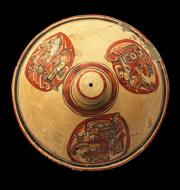 Click here to see click-through graphic of Waká artifacts.© Philip Hofstetter/ Jennifer Piehl/ Sarah Sage
Click here to see click-through graphic of Waká artifacts.© Philip Hofstetter/ Jennifer Piehl/ Sarah SageArchaeologists have entered a long-sealed crypt in Guatemala to find an ancient murder scene. The tomb, in the ancient city of Waká, contains the remains of two women, one pregnant, arranged in a ritual tableau.
Researchers say the young, wealthy women were probably slaughtered as part of a power struggle between Mayan cities. And that, they say, sheds new light on the role of women in the Mayan culture 1,600 years ago.
"This tomb tells us that women were extremely powerful," says Dorie Reents-Budet, a Maya specialist who works for the Smithsonian Institution from North Carolina. "When there were political disagreements, women were killed."
“This tomb tells us that women were extremely powerful.”
Dorie Reents-Budet
Smithsonian Institution, Washington DC
Waká, also known as El Perú, lies by the San Pedro River about 60 kilometres west of the more famous site of Tikal. Once thought to be a minor player in the Maya world, Waká has recently emerged as a key pawn in the bitter rivalry between the cities of Calakmul, to the north, and Tikal.
Women probably played an important role in those battles, says David Freidel, an archaeologist at Southern Methodist University in Dallas, Texas, who co-directs the excavations at Waká. When one Maya group conquered another, it may not have been enough to simply invade and take over. It may also have been standard practice to slay women of the elite class.
"The usurpation of power may have required the ritual and public extinction of the immediate family line," says Freidel, who runs the Waká project with archaeologist Héctor Escobedo of the University of San Carlos in Guatemala City.
Excavations at other Maya tombs had hinted at the bloodiness of such takeovers, but the findings at Waká are some of the best documented and most detailed yet.
Death of warriors
Waká reached its height between AD 400 and 800; the newfound tomb dates to the beginning of that reign, between about AD 350 and 400. It is at least two centuries older than a queen's tomb found at Waká last year.
Graduate student Michelle Rich uncovered the tomb in late April as she excavated one of three pyramids atop Waká's highest hill. Guatemala's minister of culture announced the discovery last week.
ADVERTISEMENT
Inside the tomb, both women had been carefully arranged. The pregnant one was laid face down with the other woman on top, face up. Both had shells and ear decorations arranged by their skulls. Stingray spines had been placed near their groins, a possible sign that they were regarded on the same level as warriors, says Freidel. Their deaths would have made a powerful political statement, he says.
The tomb also contained a handful of elaborately painted ceramic vessels. "This is the good stuff," says Reents-Budet, comparing the pots to the Mayan equivalent of delftware.
The artefacts and bones have been moved to the project's laboratory in Guatemala City, where they can be studied further.
Smithsonian Institution, Washington DC
